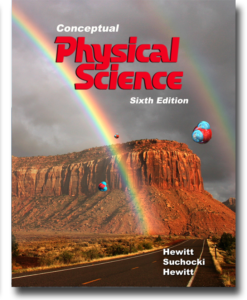
Astronomy
Presented by John Suchocki, our astronomy pre-built course uses select physics, chemistry, and astronomy chapters from the Conceptual Physical Science textbook. Through this curriculum, the physics and chemistry serve to support a deeper understanding of astronomy.
About Our Pre-Built Courses
We offer pre-built courses for all of our titles. A pre-built course works well when using Conceptual Academy much like the video version of a traditional textbook. Your students will have access to all the content listed within this pre-built course (see below). This provides flexibility from one semester to the next. For each semester you might direct students to be responsible for only select lessons or chapter sections.
Once a pre-built course is uploaded to your instructor’s account, you can modify it as you see fit to “make it your own”. This includes updating the FYI pages and setting dates for each lesson so that students know what to study by when. You can also remove select chapter sections you are not wanting students to see.
For a Conceptual Academy course aligned more precisely to a particular class schedule, we recommend you contact us to request a customized course. To learn more about customizing your course, please look to the help documents within your instructor profile page.
Conceptual Astronomy

Accompanying Printed Textbook: Conceptual Physical Science, 6e (CPS6e) Sold separately
Review a .pdf of the front matter of this textbook, including its table of contents. Here is a link to several sample pages from a chapter section on galaxies: AstronomySample.
About This Course
An introduction to the basic concepts of astronomy using key chapters from our Conceptual Physical Science textbook. This course begins with an exploration of our solar system, followed by a study of the laws of motion and gravity as described by Newton. We then dig deeper into the atomic nucleus, which sets the stage for understanding the nature of stars, black holes, and galaxies. We conclude with the big picture of the universe with a focus on Big Bang theory, cosmic inflation, Einstein’s relativity, and more recent discoveries such as dark matter and energy. Along with video lessons and reading assignments, this course includes study advice from the authors, worksheets, interactive simulations, automated quizzes, unit exams, and labs that can be completed with commonly available materials. Binoculars are highly recommended.
6 Units: 26 Lessons
Unit A: The Solar System
Unit B: Newton’s Laws
Unit C: Gravity and Satellites
Unit D: The Atomic Nucleus
Unit E: Stars and Galaxies
Unit F: The Universe
Download this document to view Chapter Section details: PreBuiltCPSAstro
About Laboratories
For this CPS—Astronomy course, ample laboratory activities are included right within the weekly lessons. The materials for these activities, such as white glue, coins, and popsicle sticks, are readily available within your household or a discount store. This is important as it allows you to assign labs for various “homework” assignments. These lab activities are collated from a the following sources:
1) You’ll find the “Think and Do” activities described within the textbook end-of-chapter material. These activities tend to be short and sweet, as well as numerous.
2) We offer “PhET Labs” that make use of computer simulations created through the PhET program sponsored by the University of Colorado. The PhET simulations themselves are embedded within a lesson’s From Your Instructor (FYI) page. For many of these simulations you’ll also find within the Doc Share a write-up worksheet that guides the student through a simulation-based activity.
3) Select lab experiments are included from the Conceptual Physics Beyond the Laboratory Manual created by professor Stephanie Blake of Ozarks Technical College, MO. This creative manual features many engaging hands-on experiments utilizing only readily available materials. For each activity, after following through a prescribed set of instructions (guided learning), the student is then pushed to create their own experimental procedure on a related subject (inquiry learning).
4) We have selected relevant labs from our official Conceptual Physical Science Lab Manual and made them available to you through the FYI pages of this course. Like the other activities, these too require materials that should be readily available. For example, to measure a star’s ascension, you need only a straw, protractor, pencil, and a weighted string.
Sample Astronomy Video: Speed of Light

“I’m the chemistry and astronomy author of our textbooks. So what do chemistry and astronomy have in common? EVERYTHING! Where do elements come from? Stars! Where does most all our energy comes from? Stars! Which two fields of science explore the extreme sizes? Answer: Chemistry and Astronomy, both essential to understanding our place in this universe.”
